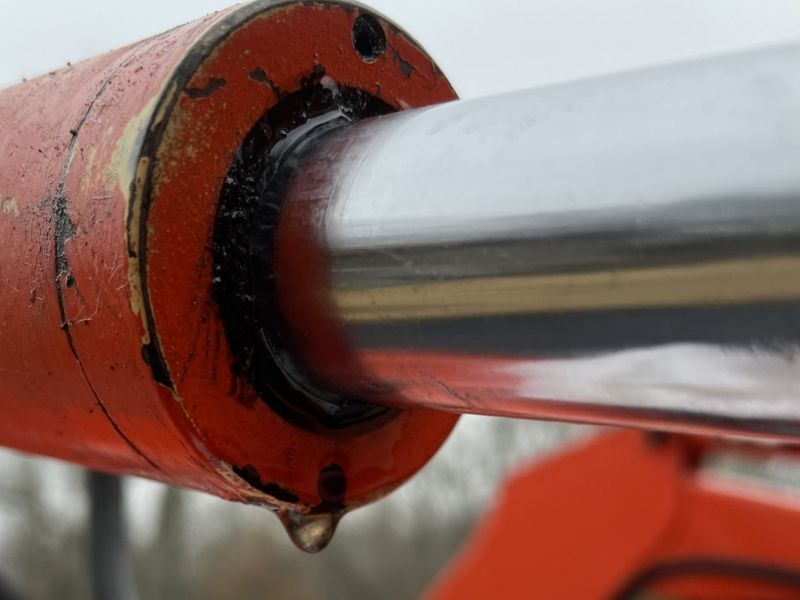
Hydraulic cylinders are integral to many industrial processes, yet they are susceptible to wear and degradation over time. Detecting early signs of deterioration through regular inspections is crucial for maintaining efficiency and avoiding costly operational disruptions.

Fluid Leaks: Seepage near seals or joints signals seal wear/damage, causing efficiency loss, environmental risks, and safety concerns.
Performance Issues: Sluggish or inconsistent piston action hints at internal wear, leaks, or lubrication faults, impacting precision and productivity.
Noise/Vibration: Uncommon sounds, vibrations during operation indicate worn components, misalignments, or poor lubrication, affecting system stability.
Reduced Power: Less force or load handling suggests piston/seal wear or fluid contamination, reducing operational capability and efficiency.
Visible Damage: Dents, cracks, corrosion on the cylinder or rod signify structural compromise, jeopardizing safety if unattended.
Operational Adjustments: Note shifts in cylinder functioning, like prolonged cycle periods, pressure maintenance difficulties, or abnormal motion patterns. These may signal underlying problems needing inspection or part substitution.
Environmental Impacts: Factor in environmental variables such as temperature swings, humidity, and contaminant exposure. Such conditions can hasten wear and corrosion, mandating proactive upkeep and prompt replacements.
Hydraulic cylinders, vital to industrial equipment, face varied challenges that can trigger wear, decay, and failure without efficient management. Grasping these factors is pivotal for proactive maintenance strategies and prolonging hydraulic systems' operational life.
Piston & Seal Degradation: Prolonged activity causes friction between pistons, seals, and cylinder walls, leading to seal erosion and piston ring damage. Seal wearing permits hydraulic leaks, diminishing system efficacy and output.
Rod & Barrel Erosion: Recurrent piston rod motion within the cylinder barrel induces abrasions over time. Contaminants increase wear on rod and cylinder surfaces, hastening deterioration.
Fatigue-Induced Damage: Continuous heavy loads or cyclic stresses prompt metal fatigue in cylinder parts, evidenced by cracks, particularly in barrel or rod areas. Timely replacement is crucial to avert catastrophic failures, ensuring structural soundness.
Moisture & Contamination Issues: Moisture intrusion in the system fosters corrosion of components like piston rods and cylinder barrels. Contaminants—dust, dirt, debris—inflict abrasive wear on seals and moving parts, undermining their efficacy.
Temperature Variations: Temperature swings impact hydraulic fluid viscosity and cylinder component mechanics. Elevated temperatures expedite seal decay and fluid degradation, whereas low temperatures thicken fluids, augmenting internal friction and undermining performance.
Insufficient Lubrication: Irregular or inadequate cylinder lubrication escalates friction and wear. Adequate lubrication is vital to minimize friction losses, safeguard seals and moving elements, and prolong cylinder operation lifespan.
Maintenance Schedule Omission: Neglecting prescribed maintenance periods can result in unnoticed wear and impending issues. Routine checks, fluid monitoring, and prompt replacement of worn components are key to detecting emergent problems and averting costly failures early on.
Replacing a hydraulic cylinder is a meticulous process that requires attention to detail to ensure safety and efficiency.
Here’s an expanded step-by-step guide with additional insights for handling different types of cylinders:
1.Equipment Shutdown: Disconnect all power and fully depressurize the hydraulic system to avert accidental activation during service.
2.Workspace Readiness: Clear the area of debris, ensuring proper lighting and ventilation. Use PPE—gloves, safety goggles, protective gear—for protection.
1.Cylinder Identification: Specify the hydraulic cylinder type needing replacement (single-/double-acting, telescopic), noting dimensions, stroke, and pressure ratings.
2.New Cylinder Inspection: Prior to fitting, meticulously check the replacement for conformity with original specs, validating seals, fittings, and mounts for equipment compatibility.
1.Disconnect Hoses: Loosen and disconnect hydraulic hoses from the cylinder ports. Use caps or plugs to seal the open ends of the hoses to prevent contamination by dirt or moisture.
2.Remove Mounting Hardware: Unscrew bolts or remove pins securing the cylinder to the equipment frame or mounting bracket. Keep track of hardware and consider labeling or organizing them for ease of reassembly.
3.Extract the Cylinder: With caution, carefully maneuver the old cylinder out of its housing. Support its weight evenly to avoid damage to surrounding components or structural integrity of the equipment.
1.Preparing the New Cylinder: Position the replacement cylinder close to the installation site. Guarantee all seals, O-rings, and fixtures are pristine, lubricated appropriately following manufacturer recommendations, and intact.
2.Alignment and Fastening: Match the new cylinder with equipment mounting points. Install and torque bolts or pins to manufacturer-specified settings. Verify alignment to prevent performance-affecting misalignments.
1.Connect Hydraulic Hoses: Attach hydraulic hoses to the corresponding ports on the new cylinder. Ensure fittings are properly aligned and tightened to prevent leaks. Conduct a visual inspection and perform a hydraulic pressure test if possible to check for leaks.
1.System Verification: Slowly reintroduce hydraulic pressure into the system. Monitor the new cylinder for seamless extension and retraction, ensuring no unusual noises or vibrations occur.
2.Fine-Tuning: Make necessary adjustments to hydraulic settings, for instance, stroke length or pressure, to enhance performance, guided by equipment manuals or technical specifications.
To conclude, prompt replacement of hydraulic cylinders is vital for maintaining operational effectiveness and averting expensive disruptions in industrial environments. Routine inspections to detect wear indicators like fluid leaks, performance decline, and visible harm are pivotal. Prioritizing proactive maintenance approaches and adherence to manufacturer protocols notably prolongs the life of hydraulic systems, augmenting productivity and reducing risks linked to unforeseen breakdowns.